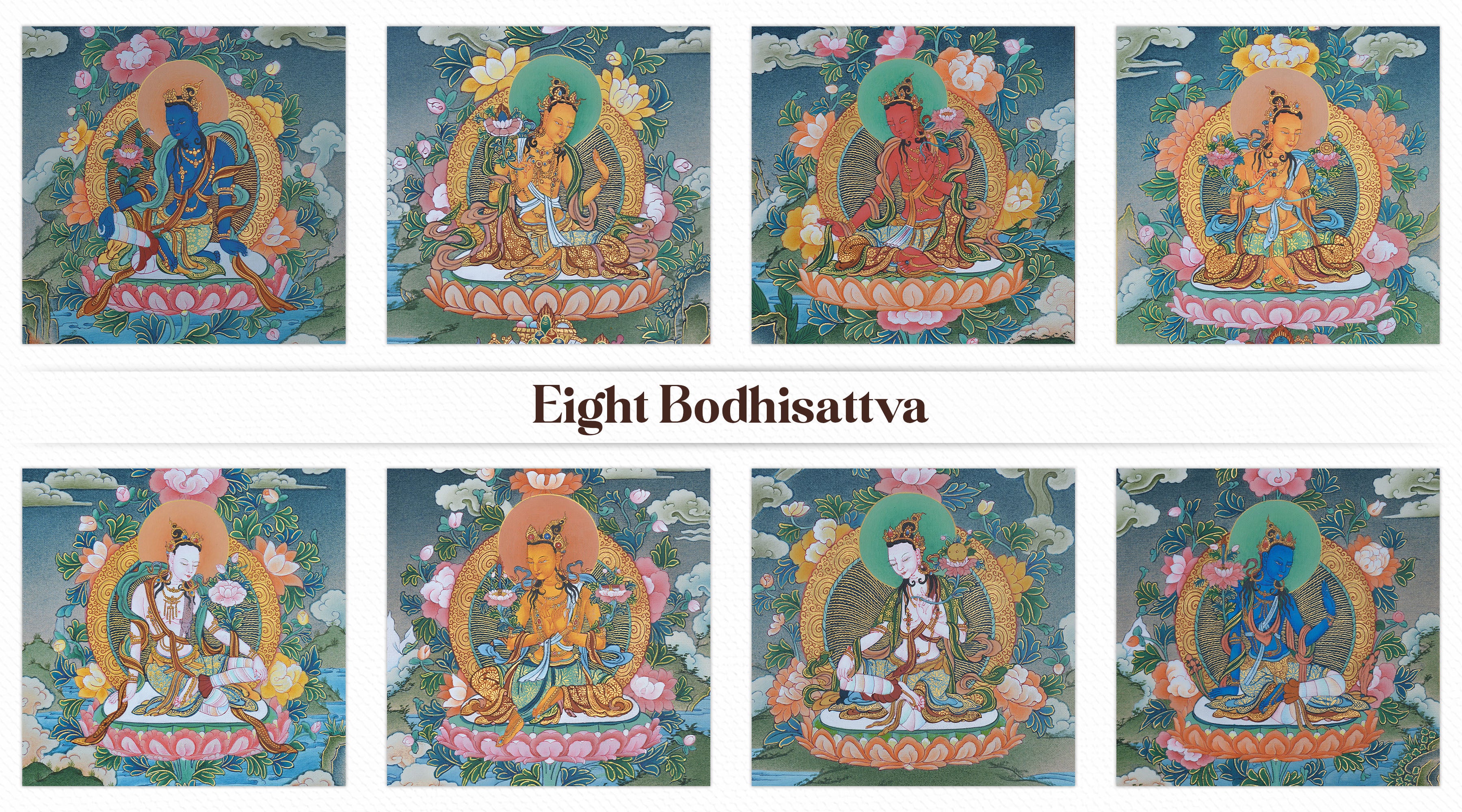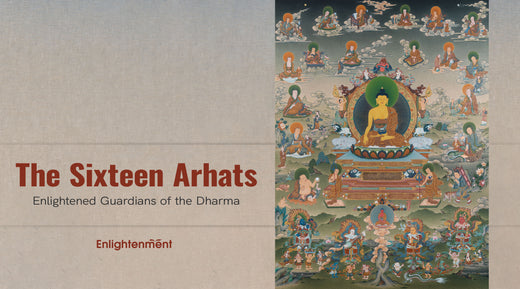Bodhisattvas are the Protectors of the Dharma
Bodhisattvas are revered as enlightened beings who have vowed to attain Buddhahood but have chosen to remain within samsara (the cycle of rebirth) to assist all sentient beings in attaining enlightenment. In Vajrayana Buddhism, they are venerated for their aid as spiritual guides, protectors, and intercessors. They also perfectly balance the highest qualities, such as compassion, wisdom, and power. Their role in Vajrayana is crucial, as they are seen as intermediaries between practitioners and the ultimate goal of Buddhahood.
As the protectors of the Dharma, Bodhisattvas not only exemplify essential virtues but they are a big part of a devotee's everyday life. They are often invoked in prayers and rituals, and their blessings are sought for guidance and protection. In addition, their teachings and stories serve as powerful inspirations, motivating individuals to cultivate similar qualities within themselves. By embodying the principles of altruism and service, they encourage practitioners to see beyond their suffering and to work towards the liberation of all beings. This deep interconnectedness emphasizes the importance of the spiritual path before the Enlightenment.
Who are the Eight Bodhisattvas of Vajrayana Buddhism?
In Vajrayana, the highly revered eight Bodhisattvas form a crucial part of meditative practices and rituals. And such great figures are:
-
Avalokiteshvara (Bodhisattva of Compassion)
-
Manjushri (Bodhisattva of Wisdom)
-
Vajrapani (Bodhisattva of Power)
-
Samantabhadra (Bodhisattva of Universal Benevolence)
-
Kshitigarbha (Bodhisattva of the Earth)
-
Maitreya (The Future Buddha)
-
Akashagarbha (Bodhisattva of Infinite Space)
-
Sarbanivarambiskambin (Bodhisattva of Removing Obstacles)
Each of these Bodhisattvas has a distinct role and personality, and their iconography is rich with symbolic meaning in arts and rituals.
1. Avalokiteshvara: The Embodiment of Infinite Compassion
Avalokiteshvara, often called Chenrezig in Tibetan, is the Bodhisattva of Compassion. The divine figure represents the infinite compassion of all Buddhas. In Vajrayana Buddhism, he is considered one of the most important Bodhisattvas and is often depicted in various forms, from peaceful to wrathful.
Iconography and Symbolism

Avalokiteshvara is frequently depicted with multiple arms and heads, symbolizing his boundless compassion that reaches out to all corners of the universe. In the iconic 1000-armed form, each hand holds a unique object representing different aspects of his compassionate activity. His mantra, "Om Mani Padme Hum," is one of the most famous in Vajrayana. He is invoked by devotees for his blessings and compassion.
In Vajrayana, the practice of Chenresig is integral to developing compassion, one of the foundational qualities on the Buddhist path. Meditation on Avalokiteshvara is believed to help practitioners cultivate the Bodhisattva's qualities and achieve the ultimate goal of Buddhahood.
2. Manjushri: The Bodhisattva of Transcendent Wisdom
Manjushri, who is referred to as Jampelyang in Tibetan, is the embodiment of wisdom. Hence, he is considered one of the most revered figures in the whole Buddhist philosophy. Wisdom (Prajna) is crucial in the path to enlightenment as it leads to the direct realization of emptiness (Shunyata), the true nature of reality.
Iconography and Symbolism

Manjushri is often depicted holding a sword in his right hand, which symbolizes the sharpness of wisdom that cuts through ignorance and delusion. In his left hand, he holds a book representing the Prajnaparamita (Perfection of Wisdom) Sutras. He is sometimes shown riding a lion, representing the fearlessness that comes with wisdom. His practices are centered around focusing on cultivating prajna, or wisdom, to see beyond dualistic perceptions of the world. Through visualization, mantra recitation, and meditation, practitioners aim to sharpen their discernment and understand the ultimate truth.
3. Vajrapani: The Bodhisattva of Power and Protection
Vajrapani, also called Chana Dorje in Tibetan, is the Bodhisattva of Power and Protection. He symbolizes the power of the Buddha's teachings and the wrathful force used to dispel ignorance and obstacles on the path to enlightenment.
Iconography and Symbolism

The Vajra wielder is typically depicted as a wrathful figure. His blue skin is the highlight of his iconography. He stands in a fierce posture, holding a vajra (thunderbolt) which symbolizes indestructible power and the force of enlightenment. His wrathful appearance is a manifestation of his commitment to protect practitioners from hindrances on their spiritual journey.
Vajrapani is invoked as a protector deity in various rituals, especially those aimed at removing obstacles and internal blockages such as ignorance and delusion. His fierce compassion is seen as a vital force in overcoming negativity.
4. Samantabhadra: The Bodhisattva of Universal Benevolence
Samantabhadra represents the Bodhisattva ideal of universal benevolence and virtue. Often called Kuntuzangpo in Tibetan, he is particularly associated with the practice of dedicating all virtuous activities for the benefit of all beings, symbolizing boundless good actions.
Iconography and Symbolism

Samantabhadra is often depicted in a meditative state, seated on a lotus, symbolizing his ultimate enlightenment. His body is often blue in color, representing the vastness of his wisdom and the sky-like nature of his mind.
Also considered a primordial Buddha, he is venerated for embodying the ultimate truth and purity of mind. He is usually accompanied by his consort, Samantabhadri, who embodies the feminine aspect of enlightenment. Samantabhadri is typically depicted in a similar posture embracing him in the Yab Yum unity. Together, they represent the primordial, innate nature of the mind.
5. Kshitigarbha: The Bodhisattva of the Earth
Kshitigarbha is the venerated protector of beings in the lower realms. He is also called Sai Nyingpo in Tibetan. His name translates to "Earth Womb," signifying his connection to the earth and his vow to save all beings from suffering. He is considered the protector of children, the deceased, and those in the underworld. His compassion and dedication to saving beings from the cycle of rebirth make him a beloved figure in many Buddhist traditions.
Iconography and Symbolism

Kshitigarbha is often portrayed as a young monk with a staff in one hand and a wish-fulfilling jewel in the other. His monk's appearance signifies his commitment to humility and simplicity. The staff he carries can open the gates of hell, while the jewel represents the light of wisdom that dispels darkness. His is invoked to help deceased beings move through the bardos (intermediate states between death and rebirth) and alleviate suffering in the lower realms.
6. Maitreya: The Future Buddha
Maitreya, also called Jampa in Tibetan, is prophesied as the future Buddha. He will appear on Earth to restore the teachings of the Dharma when they have faded. He embodies loving-kindness (maitri) as a symbol of hope and compassion for the future. His teachings are believed to be a continuation of the Buddha's message. His future appearance is eagerly awaited and he will bring a new golden age for humanity.
Iconography and Symbolism

Maitreya is typically depicted seated on a throne, signifying his future role as a Buddha. In his hands, he holds the symbols of his future enlightenment—the Dharma wheel and a vase of nectar, which represent his readiness to teach and the vitality of the teachings he will offer.
Practitioners meditate on Maitreya to cultivate loving-kindness and prepare for his eventual return. His practices are also aimed at developing a sense of hope and positive aspiration for individual progress and the future of all sentient beings.
7. Akashagarbha: The Bodhisattva of Infinite Space
Bodhisattva Akashagarbha is the embodiment of wisdom and the vastness of the mind. He is called Namkhai Nyingpo in Tibetan, and his name is translated as "Essence of Space." The name reflects his connection to the boundlessness of the universe. He is associated with cultivating knowledge, memory, and understanding. Thus, he serves as a protector for practitioners seeking to deepen their insight.
Iconography and Symbolism

Akashagarbha is often depicted as serene and peaceful in both standing and seated. He is commonly portrayed with a dark blue or black body that resonates the vastness of space and the infinite nature of wisdom. His hands may hold a mala (prayer beads) or a lotus, representing purity and spiritual growth. In many representations, he is surrounded by flames or light, emphasizing his role as a source of wisdom that dispels ignorance.
Akashagarbha is invoked for cultivating vast, all-encompassing wisdom and understanding the limitless nature of reality. His practices are aligned with helping practitioners perceive the interconnectedness of all things and the emptiness of inherent existence.
8. Sarbanivarambiskambin: The Bodhisattva of Removing Obstacles
Sarvanivaranaviskambhin is the "Bodhisattva Who Removes All Obstacles." He is highly revered for his ability to eliminate hindrances on the path to enlightenment. He embodies the excellent qualities of compassion and wisdom, helping practitioners overcome both external and internal obstacles, such as ignorance, fear, and negative karma. He is often often called upon in times of difficulty as devotees seek his guidance and support to navigate challenges in their spiritual journey.
Iconography and Symbolism

Sarvanivarana-viskambhin is typically depicted as a compassionate figure, sometimes shown with multiple arms to symbolize his ability to assist many beings simultaneously. His serene expression conveys reassurance and strength, inviting practitioners to trust in his protective presence.
He serves not only as a source of aid but also as a reminder of the importance of perseverance and faith in overcoming life’s difficulties. His teachings emphasize that through dedication and the cultivation of wisdom and compassion, one can break through barriers and move closer to enlightenment, ultimately benefiting all sentient beings.
Incorporate the Eight Bodhisattvas into Daily Practice
For modern Vajrayana practitioners, invoking the Eight Bodhisattvas can be woven into daily spiritual routines. Here are a few suggestions:
-
Daily Meditation: Select one Bodhisattva to focus on each day. Visualize their form, recite their mantra, and contemplate the qualities they embody. For example, meditating on Avalokiteshvara's form can help cultivate compassion, while meditating on Manjushri can sharpen wisdom.
-
Recitation of Mantras: The mantras associated with each Bodhisattva carry their energy and blessings. Repeating these mantras not only invokes their presence but also helps internalize their qualities. Mantras like "Om Mani Padme Hum" (Avalokiteshvara) are powerful tools in Vajrayana practice.
-
Thangka Visualizations: Use thangka art depicting the Bodhisattvas during your meditation sessions. Gazing at these intricate artworks can aid in visualization, deepening your connection with the Bodhisattva and strengthening your practice.
-
Obstacles Removal Rituals: When faced with personal or external obstacles, Vajrapani’s practices can be particularly useful. Recite his mantra or visualize his powerful form to overcome these challenges.
The Wisdom of the Eight Bodhisattvas Serve As Eternal Guides
The Eight Bodhisattvas represent key qualities essential for the spiritual development of all practitioners. One can invoke Avalokiteshvara's compassion, Manjushri's wisdom, Vajrapani's power, Samantabhadra's virtue, Kshitigarbha's guide to salvation from suffering, Maitreya's loving-kindness, Akashagarbha's guidance to recognize boundless nature of reality, and Sarvanivaranaviskambhin's power to remove obstacles lead to a serene spiritual life.
Each Bodhisattva offers a unique aspect of the path to enlightenment, yet their teachings and practices are interconnected, weaving together a comprehensive approach to devotional practice. From personal growth to the welfare of a civilization, the Bodhisattvas have been serving as the sentient beings' eternal guides.


